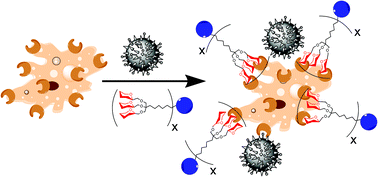Sugared biomaterial binding lectins: achievements and perspectives†
Abstract
Lectins, a distinct group of glycan-binding proteins, play a prominent role in the immune system ranging from pathogen recognition and tuning of inflammation to cell adhesion or cellular signalling. The possibilities of their detailed study expanded along with the rapid development of biomaterials in the last decade. The immense knowledge of all aspects of glycan–lectin interactions both in vitro and in vivo may be efficiently used in bioimaging, targeted drug delivery, diagnostic and analytic biological methods. Practically applicable examples comprise photoluminescence and optical biosensors, ingenious three-dimensional carbohydrate microarrays for high-throughput screening, matrices for magnetic resonance imaging, targeted hyperthermal treatment of cancer tissues, selective inhibitors of bacterial toxins and pathogen-recognising lectin receptors, and many others. This review aims to present an up-to-date systematic overview of glycan-decorated biomaterials promising for interactions with lectins, especially those applicable in biology, biotechnology or medicine. The lectins of interest include galectin-1, -3 and -7 participating in tumour progression, bacterial lectins from Pseudomonas aeruginosa (PA-IL), E. coli (Fim-H) and Clostridium botulinum (HA33) or DC-SIGN, receptors of macrophages and dendritic cells. The spectrum of lectin-binding biomaterials covered herein ranges from glycosylated organic structures, calixarene and fullerene cores over glycopeptides and glycoproteins, functionalised carbohydrate scaffolds of cyclodextrin or chitin to self-assembling glycopolymer clusters, gels, micelles and liposomes. Glyconanoparticles, glycan arrays, and other biomaterials with a solid core are described in detail, including inorganic matrices like hydroxyapatite or stainless steel for bioimplants.

- This article is part of the themed collection: Open access articles from Biomaterials Science

 Please wait while we load your content...
Please wait while we load your content...